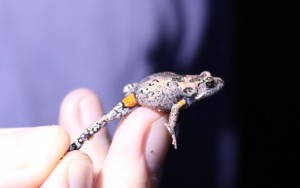Australia’s New Flasher Frog
Thursday, November 10th, 2016November 10, 2016
Flash! Flash! Flash! No, it’s not photographers following around Hollywood stars. It’s a new species of frog that flashes in a different kind of way, with a showy display to ward off attackers. Dr. Simon Clulow of the University of Newcastle in New South Wales, Australia, and his team discovered this new species while surveying amphibians in a coastal sand swamp at Oyster Cove, about 6 miles (10 kilometers) from Newcastle Airport. New vertebrate discoveries are rare, but it is incredibly rare to discover a new species so close to a populated area. Newcastle is the second most populated area of New South Wales (only Sydney is larger).

Australia’s tiny new frog species, Mahony’s toadlet, shows off part of its flashy under area. The species was discovered in a relatively urban environment near Newcastle, Australia, in 2016. Credit: © University of Newcastle
The tiny Mahony’s toadlet (Uperoleia mahonyi), also known as the “flasher frog,” is named after Professor Michael Mahony, a renowned frog expert and conservationist and Dr. Clulow’s mentor and supervisor. The frog has warty glands on its back similar to toads, and it fits on the tip of an adult person’s thumb. One of the frog’s defining characteristics is its beautiful black-and-white marblelike belly. Its unique belly pattern, one not witnessed in Australia before, led Clulow to recognize the frog as a new species not previously described. One other unique characteristic is what puts this frog over the top—its flashing ability! If its natural camouflage fails to hide it from predators, the frog will flash the bright orange rust color of its groin area. This brightly colored area, which remains hidden while the frog is resting, contrasts sharply with the rest of the frog, so it delivers quite a shock to such likely attackers as birds, rats, and snakes. The flash-driven pause of the attacker often allows Mahony’s toadlet to dart away and disappear into the undergrowth of its swampy environment.
At the moment, the habitats where Mahony’s toadlets live are relatively safe and in good condition, but with encroaching housing developments, sand mining, and other human activities, Mahony’s toadlet may be gone more quickly than it was found. Researchers estimate the flasher frog population to be rather small, so conservation efforts must be made to help this new species of frog continue to thrive and flash, flash, flash.


